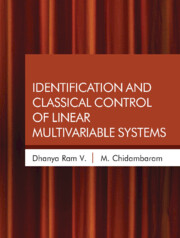Book contents
- Frontmatter
- Contents
- Preface
- Acknowledgements
- List of Abbreviations
- Notations
- 1 Models, Control Theory, and Examples
- 2 Identification and Control of SISO Systems
- 3 Introduction to Linear Multivariable Systems
- 4 CRC Method for Identifying TITO Systems
- 5 CRC Method for Identifying SISO Systems by CSOPTD Models
- 6 CRC Method for Identifying TITO Systems by CSOPTD Models
- 7 Identification of StableMIMO System by Optimization Method
- 8 Identification of Centralized ControlledMultivariable Systems
- 9 Identification of Multivariable SOPTD Models by Optimization Method
- 10 Identification of Unstable TITO Systems by Optimization Technique
- 11 Centralized PI Controllers Based on Steady State Gain Matrix
- 12 SSGM Identification and Control of Unstable Multivariable Systems
- 13 Control of Stable Non-square MIMO Systems
- 14 Control of Unstable Non-square Systems
- 15 Trends in Control ofMultivariable Systems
- Appendix A Identification of Unstable Second Order Transfer Function Model with a Zero by Optimization Method
- Appendix B For Chapter 3
- Appendix C For Chapter 7
- Bibliography
- Index
10 - Identification of Unstable TITO Systems by Optimization Technique
Published online by Cambridge University Press: 31 July 2022
- Frontmatter
- Contents
- Preface
- Acknowledgements
- List of Abbreviations
- Notations
- 1 Models, Control Theory, and Examples
- 2 Identification and Control of SISO Systems
- 3 Introduction to Linear Multivariable Systems
- 4 CRC Method for Identifying TITO Systems
- 5 CRC Method for Identifying SISO Systems by CSOPTD Models
- 6 CRC Method for Identifying TITO Systems by CSOPTD Models
- 7 Identification of StableMIMO System by Optimization Method
- 8 Identification of Centralized ControlledMultivariable Systems
- 9 Identification of Multivariable SOPTD Models by Optimization Method
- 10 Identification of Unstable TITO Systems by Optimization Technique
- 11 Centralized PI Controllers Based on Steady State Gain Matrix
- 12 SSGM Identification and Control of Unstable Multivariable Systems
- 13 Control of Stable Non-square MIMO Systems
- 14 Control of Unstable Non-square Systems
- 15 Trends in Control ofMultivariable Systems
- Appendix A Identification of Unstable Second Order Transfer Function Model with a Zero by Optimization Method
- Appendix B For Chapter 3
- Appendix C For Chapter 7
- Bibliography
- Index
Summary
In this chapter, a generalized technique is discussed to obtain the initial guess values for individual transfer function processes of the unstable Two Input Two Output (TITO) multivariable systems. To determine the lower and the upper bounds to be used in the optimization technique, a simple method is explained. Section 10.1 discusses the proposed design method to identify the model parameters of a TITO system under decentralized controller along with the analytical expressions to determine the initial guess values. The applicability of the method is demonstrated with two simulated unstable systems. The method is also extended to unstable TITO system under centralized controllers. Simulation examples show that the proposed method gives a quick convergence with less computational time. For solving the optimization problem, lsqnonlin routine in Matlab is used.
Identification of Systems with Decentralized PI Controllers
The decentralized multivariable system shown in Fig. 3.2 (Chapter 3) is considered. The main loop diagonal transfer function models are unstable FOPTD. The process transfer function matrix Gp(s) and the decentralized controller matrix Gc(s) are given as in Eq. (10.1).
The unstable system can be stabilized by the decentralized control scheme. The controller settings can be selected to obtain a reasonable stable process response. The present example focuses on the identification of the systems having the main loop diagonal transfer functions (g11 and g22) as unstable and the off diagonal transfer function (g12 and g21) as stable.
In general, the transfer function models used are expressed as in Eq. (10.2).
The set point yr1 is perturbed with the other loops closed and other set points unchanged. From this set point change, the main response y11 and the interaction y21 is obtained. Similarly, yr2 is perturbed to obtain the main response y22 and the interaction y12. The initial guess value plays an important role in the optimization technique. For the identification of the model, these response values are used to find the initial guess values for which a straightforward method is suggested. The initial guess values for time delay are considered to be the same as the corresponding closed loop time delay values and the time constant is considered as ts/8 where ts are the settling time of closed loop responses. The initial guess values for kp11 and kp22 are obtained from the relation given in Eq. (10.3) (Chidambaram, 1998).
- Type
- Chapter
- Information
- Publisher: Cambridge University PressPrint publication year: 2023

